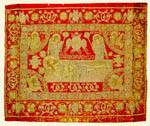|
|
| Church Embroidery |
14th and 15th c. Stavronikita Monastery 91.5 x 113 cm Mount Athos workshop |
|

|
This epitaphios is embroidered on red silk, in some places now worn through to the lining. The figure of the dead Christ, laid out on the linen cloth, occupies the centre of the scene, surmounted by the inscription 'Jesus Christ. The Entombment'. A cruciate halo surrounds his head, and his hands are crossed over his loincloth. Symmetrically positioned behind him are two angel-deacons with liturgical fans. Within quadrants at the corners are the symbols of the Evangelists, in the following order: Sts Matthew, John the Theologian, Mark, Luke. Cherubs occupy the spaces at the head and foot of Christ and between the two angels. Double wheels (thrones) and crosses ornament the foreground, in front of the bier. Two crosses within circles and a rosette fill in the remaining spaces. The scene is framed by a narrow border with the familiar Palaeologan motif of crosses within circles linked by half-acanthus leaves. The whole is finished by a wide border decorated with cherubs and double wheels separated by crosses within circles. The work appears to belong to two different periods, with sections of an older epitaphios, apparently damaged or worn, having been patched on the red silk. Both the large 'linen cloth' impinging on the symbols of the Evangelists in the lower corners and disrupting the balance of the composition, and the second border, seem to indicate that the figure of Christ was not part of the initial design. The iconographic theme is the symbolic representation of the sacrificial Lamb, surrounded by angelic hosts and the symbols of the Evangelists. The symmetrical composition, with the horizontal shroud (in some examples the sepulchre), the two angel-deacons with their liturgical fans venerating behind, the symbols of the Evangelists in the corners, and the ornamental motifs on the ground and the inner border recur in a series of fourteenth-century epitaphioi studied by Millet. A variation of the spiral motif decorating the arcs in the corners appears on the collar of a sakkos in the Vatican (14th c.) and on the epigonation of Metropolitan Anthimos in the Tismana Monastery (1370): these comparanda may indicate the approximate date of the earlier epitaphios. For the later work, comparisons may be made with the epitaphios of Metropolitan Makarios of Moldavia-Wallachia (1428) and those in the Meteora Monastery and in the Church of St Nicholas Radaut (today the Museum of Sucevita), although an even more recent 'renovation' based on older models cannot be excluded. The original embroidery, which has been stitched onto the textile, is worked in fine gold and silver wire in kavaliki, kamares and riza stitch. The artist used silk of a pale pearl shade for the faces, with tinted 'brushstrokes' for the features, and a chestnut brown for the hair and beards. The body of Christ is rendered in a delicate wheaten tone in densely worked riza stitch, with shadings of a darker colour heightening the modelled effect.
| |
|
Bibliography: Patrinelis - Karakatsani - Theochari 1974, p. 147, fig. 54.
| ||
| M. Th. | ||
| Index of exhibits of Monastery of Stavronikita 14th century |
||
Reference address : https://www.elpenor.org/athos/en/e218ck20.asp